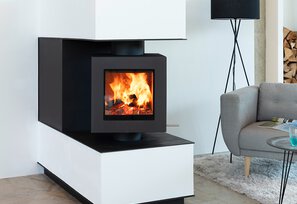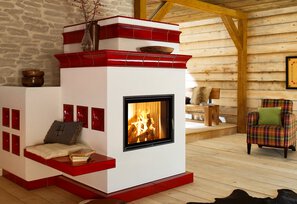Fireplace cladding
What are the options?
A fireplace cladding is what gives the fireplace its special appearance. It is like the individual frame for a beautiful picture, in which can only develop its full effect through it. There are many different materials and colour designs to choose from, from a stone look to plaster.

Ideas for fireplace cladding
There are many ways to provide your fireplace with a beautiful, attractive lining. When it comes to the cladding, there is a choice between bricks for walling in or fireplace construction panels.
It is important to use heat-resistant materials such as clinker, fireclay or panels.
Modern, classic or rustic? The options are wide-ranging, because the fireplace cladding should not only match the fireplace or stove, but also the entire room. It should also harmonise with the colour of the walls and the floor. In addition to the visual appearance, there is the question of which heat properties the fireplace cladding should fulfil.
If the fireplace is used as a permanent heating system, natural stones with good storage properties are recommended. Whether sandstone, ceramic or steel, all materials have different properties and advantages. Important: They must always be fireproof, since high temperatures are generated in a fireplace.
How to clad a fireplace
When it comes to cladding fireplaces, tiles are still a classic and do not necessarily have to look rustic, even if they are made of ceramic.
Tiles have the advantage of even heat distribution and a huge choice of shapes and colours. In addition, tile claddings can be easily replaced if they should no longer be to your liking. However, tiled stoves have their price.
Plastered fireplaces are also popular, here it is important to choose fireplace plaster material that can withstand the high temperatures. Even a fireplace kit made of exposed concrete can be easily customised with textured plaster or a simple coat of paint.
Materials are suitable for fireplace cladding
Fireplace cladding includes surrounding stones, fireplace construction panels and the colour design. Natural stone is used if the wood stove is to store maximum heat.
Marble, soapstone or sandstone are used particularly frequently. The typical feature of natural stone is its porous nature. This means that it retains the heat optimally and releases the energy into the room in the form of radiant heat even hours after heating.
Soapstone has the highest storage capacity, while sandstone has a higher thermal conductivity, which means that it heats up more quickly. In addition, natural stone never looks the same, so every fireplace or stove is unique. Natural stone looks lively, unusual and aesthetic. The disadvantage: natural stone is often more difficult to work with than, for example, fireplace construction panels. They are a good alternative and also a good option for the colour design of the fireplace.

Who makes fireplace claddings?
You can have your fireplace designed and clad by a professional or furnace builder according to your own wishes. But you can also do it yourself.
The fireplace insert is already in place, the wall behind it and the floor come with heat insulation in accordance with fire safety regulations. And have you prepared the work equipment? Then you can start. The cladding parts are cut to size and fitted. The more carefully the work is done, the more beautiful the result.
If tiles are used, the individual components must be grouted.
Attention: Here, too, the material must be heat-resistant. If necessary and depending on taste, the cladding is plastered and the fireplace or stove is ready.

Conclusion
Tastes vary. This also applies to the appearance of the fireplace. When it comes to fireplace cladding, you can really let your imagination run wild and choose from a wide variety of materials and design options. Skilled people can even do it themselves.












